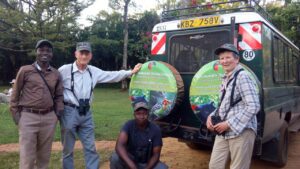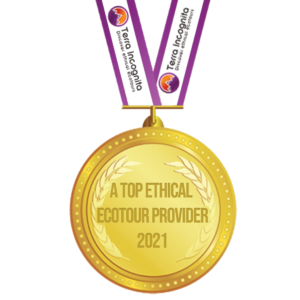Nairobi National Park Birding Tour
Located on the southern outskirts of the city, Nairobi National Park may be one of Africa’s smallest national parks (117 sq km), yet it offers so much. With expansive open plains set against the backdrop of the city’s impressive skyline, it stands as the sole national park bordering a metropolis.
Particularly noteworthy is the park’s remarkable diversity of birdlife, with a recorded count of over 520 species. On our day tours to Nairobi National Park, you can expect a whopping count of 120+ species – that number can even get surpassed on good days out
Another highlight, is that park boasts a wide array of African big game, including the endangered black rhino—a testament to the park’s conservation success—alongside lions, leopards, hyenas, buffaloes, and giraffes.
Nairobi National Park
Nairobi National Park, Kenya’s oldest, is a mere 7 kilometers from the heart of the nation’s capital. Widely regarded as the best birding location in Kenya, it boasts an impressive count of over 500 recorded bird species. Encompassing an expanse of 117.21 square kilometers, this park offers an ideal setting for a full day dedicated to birdwatching.
Typically, a day’s tour yields an impressive average of 170-220 species. However, our past tours have seen this count surpassed on exceptionally productive days.
Pick-up is scheduled at 6 am. A brief drive to the park gate will treat you to Nairobi’s stunning sunrise. Upon arrival, we’ll be focusing on observing forest edge species, seen close to the park entrance. Subsequently, we’ll continue into the open plains, offering a shift in habitat, with intermittent stops at various wetlands within the park. After a picnic lunch, we’ll be get the opportunity to do some for on-foot birding around the picnic site. We’ll then spend the whole afternoon looking for any species we might have missed.
At 5:30 pm, after a rewarding day of birding, we’ll begin our return journey to Nairobi. Before departure, we’ll review our extensive checklist, celebrating the plethora of species spotted – an occasion for well-deserved bragging rights.
Tour pace
Slow/Medium
Tour difficulty
Easy – most activities done via safari vehicle along with a guided ‘bush walk’.
Best time of year to visit
Although generally great all year round, the best time to visit Nairobi National Park for a birding tour, falls within the short rains of November and early December. This period showcases most species in vibrant breeding plumage, featuring captivating display behaviours of whydahs, widowbirds and bishops. Additionally, it’s when numerous Palearctic migrants make their presence felt, so the count will be high.
Sustainability:
At Sustainable Birding, our goal is to ensure that every birding holiday we create contributes positively to bird conservation efforts and local communities. Our determination to promote sustainable travel led us to become founding members of Tourism Declares Climate Emergency. As part of this commitment, we have established the world’s pioneering carbon scoring and offsetting framework for tailor-made holidays. Feel free to request us to carbon score your individual trip!
Tour Leader:
Paul grew up in the northern part of Kenya, particularly in Laikipia, an area abundant in cultural heritage and wildlife. His upbringing played a crucial role in cultivating his passion for adventure.
As an energetic and resourceful tour guide with several years of experience in travel arrangement and reservation services in East Africa, Paul is adept at conducting research to optimize travel plans. He possesses extensive experience in organizing itineraries based on time frames, weather conditions, and events, always dedicated to providing clients with the best customer service and travel experience possible.
Paul holds a special attachment and attention to authentic wildlife, birdlife, culture, scenic land, historical sites, flora, and fauna in East Africa. It is his pleasure to guide clients through most, if not all, attractions to experience the untamed savannah bush fully—wildlife viewing, relaxing on sunny, sandy white beaches, tackling challenging landscapes for mountain climbing, exploring the hot, unending great plains of the north during desert safaris, and discovering unimaginable destinations and landscapes during sightseeing. This includes exclusive hidden gems and safaris tailored for honeymooners, among others.
As a staunch supporter and promoter of eco-tourism, Paul advocates for the preservation of parks’ sensitive ecosystems and actively advocates for safe and sustainable safaris, guaranteeing clients’ safety by ensuring they have the right tour vehicle and equipment to conquer terrains, coupled with excellent service delivery in both guiding and comfortable stays, ensuring nothing but the best and most memorable experiences.
His favourite bird is the Kenya endemic, William’s Lark.

Nairobi National Park Birding Tour

A Few Highlighted Bird Species
• Secretarybird
• African Water Rail
• Spotted Thick-knee
• Black-winged Plover
• African Finfoot
• Pangani Longclaw
• Jackson’s Widowbird
• Kori Bustard
• Hartlaub’s Bustard
• Saddle-billed Stork
• African Yellow White-eye
• Common Nightingale
• Ruppell’s Robin-chat
• Northern Pied Babbler
• White-tailed Lark
• Rufous-naped Lark
• Somali Short-toed Lark
• Red-throated Tit
• Speke’s Weaver
• Grey Crowned Crane
• Yellow-necked Spurfowl
• Martial Eagle
• African Crowned Eagle
• Wahlberg’s Eagle
• African Fish Eagle
• African Quail-finch
• Zebra Waxbill
• Harlequin Quail
• Pin-tailed Whydah
• Lappet-faced Vulture
• Violet Wood-hoopoe
-
DepartureNairobi
-
Departure Time6am
-
Return Time6pm
-
IncludedTransfers inside NairobiLead bird guide and driver4WD safari vehicle with 'pop-up' roofNational park feesRanger feesPicnic lunch inside the parkMineral water inside the vehicle
-
Not IncludedSnacks and beverages




